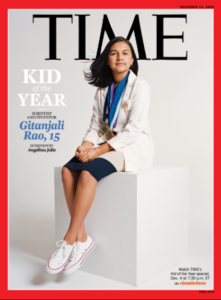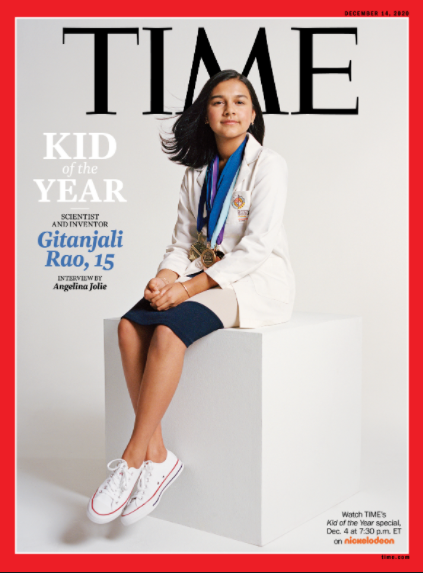The world belongs to those who shape it. And however uncertain that world may feel at a given moment, the reassuring reality seems to be that each new generation produces more of what these kids—five Kid of the Year finalists selected from a field of more than 5,000 Americans, ages 8 to 16—have already achieved: positive impact, in all sizes.

Meet TIME’s First-Ever Kid of the Year
Kid of the Year: Gitanjali Rao, 15
Lone Tree, Colo.
“Observe, brainstorm, research, build and communicate.” That is what the brilliant young scientist and inventor Gitanjali Rao told actor and activist Angelina Jolie about her process, over Zoom, from her home in Colorado, during a break in her virtual schooling. Just 15 years old, Rao has been selected from a field of more than 5,000 nominees as TIME’s first ever Kid of the Year. She spoke about her astonishing work using technology to tackle issues ranging from contaminated drinking water to opioid addiction and cyberbullying, and about her mission to create a global community of young innovators to solve problems the world over. Even over video chat, her brilliant mind and generous spirit shone through, along with her inspiring message to other young people: don’t try to fix every problem, just focus on one that excites you. “If I can do it,” she said, “anybody can do it.”
I feel like there wasn’t really one specific aha moment. I was always someone who wanted to put a smile on someone’s face. That was my everyday goal, just to make someone happy. And it soon turned into, How can we bring positivity and community to the place we live? And then when I was in second or third grade, I started thinking about how can we use science and technology to create social change. I was like 10 when I told my parents that I wanted to research carbon nanotube sensor technology at the Denver Water quality research lab, and my mom was like, “A what?” [Editor’s note: they are cylindrical molecules made of carbon atoms that are very sensitive to chemical changes, and thus are good for detecting chemicals in water, among other uses.] It was just that changing factor of, you know this work is going to be in our generation’s hands pretty soon. So if no one else is gonna do it, I’m gonna do it.
It’s a service called Kindly—there’s an app and a Chrome extension—which is able to detect cyberbullying at an early stage, based on artificial-intelligence technology. I started to hard-code in some words that could be considered bullying, and then my engine took those words and identified words that are similar. You type in a word or phrase, and it’s able to pick it up if it’s bullying, and it gives you the option to edit it or send it the way it is. The goal is not to punish. As a teenager, I know teenagers tend to lash out sometimes. Instead, it gives you the chance to rethink what you’re saying so that you know what to do next time around.
・・・
I don’t look like your typical scientist. Everything I see on TV is that it’s an older, usually white man as a scientist. It’s weird to me that it was almost like people had assigned roles, regarding like their gender, their age, the color of their skin. My goal has really shifted not only from creating my own devices to solve the world’s problems, but inspiring others to do the same as well. Because, from personal experience, it’s not easy when you don’t see anyone else like you. So I really want to put out that message: If I can do it, you can do it, and anyone can do it.
I just looked at what worked for me and decided to share it with everyone else. So I made this process that I use for everything now: it’s observe, brainstorm, research, build, communicate. It started with a simple presentation and lesson plans, and then I started adding labs and contests that students could do. Now I’ve partnered with rural schools, girls in STEM organizations, museums all across the world, and bigger organizations like Shanghai International Youth Science and Technology group and the Royal Academy of Engineering in London to run innovation workshops.
The students that I work with, they just don’t know where to start. I think that if you give them that spark that they can then build off of, then that changes everything. That means one more person in this world wants to come up with ideas to solve problems.
At the end of every workshop, everyone has something that they can start working on. If you can do this in 45 minutes to an hour, imagine what you can do if you spend months and months working on it. I’m so excited when I get an email like, “Hey, I attended your workshop four months ago and here’s my finished product, I really love it, it’s a shoe that calls 911.”
I’m currently working on an easy way to help detect bio-contaminants in water—things like parasites. I’m hoping for this to be something that’s inexpensive and accurate so that people in third-world countries can identify what’s in their water.
And I recently hit my goal of 30,000 students who I have mentored, which is superexciting. It’s like creating a community of innovators. I really hope the work that all of these kids are doing identifies innovation as a necessity and not something that’s a choice anymore. I hope I can be a small part of that.
Yeah. Our generation is facing so many problems that we’ve never seen before. But then at the same time we’re facing old problems that still exist. Like, we’re sitting here in the middle of a new global pandemic, and we’re also like still facing human-rights issues. There are problems that we did not create but that we now have to solve, like climate change and cyberbullying with the introduction of technology.
I think more than anything right now, we just need to find that one thing we’re passionate about and solve it. Even if it’s something as small as, I want to find an easy way to pick up litter. Everything makes a difference. Don’t feel pressured to come up with something big.
Most of my work with the bio-contaminants is based on a gene-based therapy solution which I’m still trying to figure out. I’m also working on a product that helps to diagnose prescription-opioid addiction at an early stage based on protein production of the mu opioid receptor gene. I’ve been really, really interested in genetics. That’s what I like, so that’s what I’m deciding to work on.
My pop-culture news is actually MIT Tech Review. I read it constantly. I think that’s really where inspiration strikes: hearing about all these amazing people at schools like MIT and Harvard who are doing such amazing work with technology. And I try to connect it back to what I see out there and put it together in a way that no one’s seen before.
Actually I spend more time doing 15-year-old things during quarantine. I bake an ungodly amount. It’s not good, but it’s baking. And, like, it’s science too.
I guess not, no. To be fair, most of the time we don’t have eggs at home, or like flour, so I have to like go online and search eggless, flourless, sugarless cookies, and then I try to make that. I made bread recently and it was good, so I’m proud of myself.
Gitanjali Rao, 15-year-old Lone Tree girl, named TIME’s first-ever Kid of the Year
Colorado teen scientist named Time’s first-ever ‘Kid of the Year’ in 2020
 English
English 日本語
日本語
